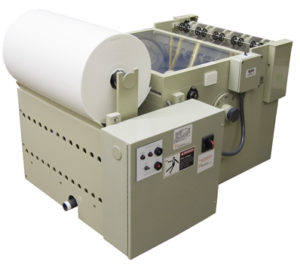Wastewater Treatment System for Chemical Etching Plants
Chemcut manufactures a batch wastewater treatment system to support Chemcut wet process systems. Our wastewater treatment process utilizes an ion exchange and/or sequential batch technologies that follow specific wastewater treatment steps.
Our systems are made of corrosion-resistant materials suitable for use in etching plants and other corrosive locations. They are designed for manual control for facility-wide or point-of-source applications.
Wastewater Treatment System Options
Batch Wastewater Treatment
Cascade Rinse
Closed-Loop Systems
Cooling Water Reduction
Electrowinning system is available in conjunction with ion-exchange
Filtration
Point of Source Treatment
Rinse Water Conservation
Filter Press
Pros of Using Chemcut’s Wastewater Treatment
Twice our wastewater treatment systems have been recognized by the Pennsylvania Governors Award for Environmental Excellence.
Our waste treatment systems are designed for reducing operating costs, minimizing maintenance costs, and saving water. We will provide you with the proper steps to wastewater treatment needed to run our system.
Rinse Water Conservation
Cascade Rinse.
We have designed an efficient cascade rinse that can be utilized after every chemical station to reduce the chemistry load on the wastewater treatment unit.
The most important chemistry to reduce is stripping chemistry which can complex metal ions and make them difficult to remove from the water.
Ion Exchange.
For customers interested in lowering their water usage, we have a closed-loop cascade rinse system. The cascade system is paired with an ion-exchange unit which allows you to run an etcher rinse without adding water.
The only water that will need to be added to a closed-loop system is water that is lost to evaporation.
Depending on the rate of metal loading, ion exchange resin (columns) will need regenerating on occasion. In conjunction with an electrowinning cell, copper can be recovered during the regeneration process by plating the copper out in an acidic state. (Not used for ferric chloride etching)
Batch Wastewater Treatment.
Even if you have a closed-loop system on the etcher you will need to treat the waste from spills and other wet processing equipment. We are here to make sure your etching plant is a success. We will provide you with the steps to wastewater treatment that our experts have developed.
The wastewater treatment system we offer collects the liquid that exits the wet processing equipment and transfers it to a “wastewater collection tank.”
When there is enough wastewater to run a batch treatment the waste can be transferred into the “reaction tank.” In the reaction tank, the pH will be adjusted and a flocculent and polymer will be added to the water. These chemicals will react causing the heavy metals to coagulate and settle at the bottom of the tank.
The clear water can now be decanted and the sludge (coagulated heavy metals and polymer) will be discharged through the Filter Press.
This system is capable of processing waste rinse water from ferric chloride etching, cupric chloride etching, and various other metal etching rinses.
Our system is not designed to handle concentrated wastes. If you would like a detailed breakdown of our “steps to wastewater treatment process” please contact us.
Cooling Water Reduction.
The sumps are designed for optimal stirring of etchant or other chemistries. The stirring of liquid helps to reduce the needed cooling water.
If you want to fully optimize your cooling water, you will need a re-circulation pump. A re-circulation pump will increase the stirring of the chemistry in the sump which will increase the cooling efficiency.
A re-circulation pump will reduce your cooling water usage and will reduce the electricity used to heat the etching chemistry.
MADE IN THE USA
Contact Us with Your Waste Treatment Needs
To help us evaluate your specific needs for a wastewater treatment plant, complete and submit the “Waste Water System Selection Questionnaire” found on the Technical page.








